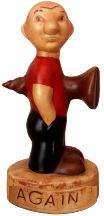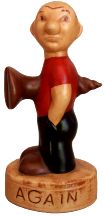 |
 The Virtual Corkscrew Museum's Weekly Newspaper |
 |
 |
 The Virtual Corkscrew Museum's Weekly Newspaper |
 |
|
Sunday, June 21, 2009 |
Number 562 |
Advertising Bows
An advertisement from the British Medical Journal published by the British Medical Association in 1881.
This review of Chateau Palugyay was published in the December 15, 1880 issue of The London Medical Record.
Under this title Messrs. Kinon and Fabre, of Regent Street, the agents for the proprietors, Messrs. J. Palugyay and Sons the famous wine-merchahts and growers of Presburg, Hungary, import an Hungarian wine of very high quality indeed. Many Hungarian wines introduced into this country have had certain drawbacks, either of coarseness or of imperfect manufacture ; and it is only when the highest qualities are reached that Hungarian wines can be fairly said to compete with French wines in perfection of manufacture. This wine, on the contrary, is singularly delicate, pure, and well made, and possesses for the connoisseur a quality equivalent to that of very high-class Burgundy, for which it was recently mistaken by a French grower experienced in such matters, to whom we submitted it. Chateau Palugyay is a wine of rare quality, and will certainly take a permanent place among the favourite wines of all connoisseurs. Physicians often look for a pure, generous, and unsophisticated wine—a thing which is much more often talked of than found—and we believe that the Chateau Palugyay will always deserve what we can now fairly say of it, that it possesses the qualities we have enumerated.
In the January 15, 1881 issue of The Sanitary Record a story announces that Messrs. Kinen and Fabre were appointed agents of Messrs. J. Palugyay and Son for the sale of "this excellent" Chareau Palugyay Wine. The article continues with:
Hungarian wines, except those of the highest class, are generally reproached with being somewhat rough and wanting in the qualities of manufacture which are essential to their maturing and keeping, and which probably, in some measure from long 'use and wont' are seldom bound absent in the produce of the French vineyards. No faults of this kind can, however, be detected in the Chateau Palugyay wine; of a Burgundy character, sound and soft enough to please the most fastidious palate, it is further recommended by its agreeable and characteristic bouquet. One of the qualities here enumerated, the soundness of the wine, renders it specially suitable as a tonic in cases of anemia and kindred ailments where red wine is needed, whilst its agreeable qualities of flavour will recommend it equally to the great number of persons who habitually use Burgundy wine as the usual stimulant taken with their luncheon and dinner. Should the Chateau Paluyay wine maintain the high standard of the sample which was submitted to our investigation, which we see no reason to doubt, it will certainly gain deserved favour with physician, patient, and public.
The firm of Pierre Dostert, distillers of liqueurs, was located at 8 rue de Luxembourg in Esch/Alzette, Luxembourg. Pierre was born March 29, 1872.

Pierre Dostert in 1930.

Marked D. WATERS & SON, XMAS 1924
The Indian Head Wine & Liquor Co. was located in the Northwest Territories of Canada. On January 20, 1908 a case was heard in the Supreme Court of Canada. Indian Head had sued skinner on January 25, 1902 for $411.34 for an overdue bill and $282.05 for additional goods. Among other objections, the defence claimed Indian Head did not have a license for selling intoxicating liquors. Indian Head, however, claimed a valid license taken out in the name Pierre Remy Blisson, of one of the owners. Ultimately, the court awarded Indian Head $50.10 The Indian Head Wine & Liquor Co.
Marked DEWAR'S SCOTCH WHISKY on both sides
John Dewar founded his firm in 1848 in Perth, Scotland. His whisky was one of the first to be sold in a glass bottle with the whisky brand name embossed on the front. The firm of John Dewar & Sons, Ltd. is still in operation.

Marked "Castle Packets"
Castle Packets Company merged with Union Steamship Co. in March of 1900 to form the Union-Castle Mail Steamship Company. The corkscrew predates 1900.
Louis Strauss' 1949 United States Patent for a "Utility Tool Kit" can be found in leather pouches with advertising. Strauss' folding bow was sold as the "Toolmaster". See the August 2, 2003 issue for more on Strauss.
The most common folding bow with advertising is William Rockwell Clough's United States Number 302,321 of July 22, 1884. This colorful miniature bow can be found with a great variety of advertisements.
The bows below were shown in the May 17, 2009 issue.
Miniature Liquor Bottles

On airlines today, you get miniature liquor bottles with twist off caps. Here are four much older miniatures with corks instead of caps. They came complete with corkscrews.
New Book
|
©2009 Don Bull, Editor |